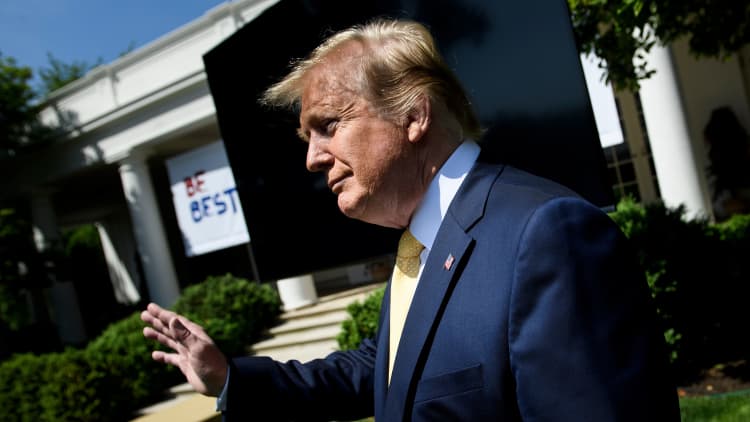
President Donald Trump's threats to slap more tariffs on China are being viewed as a bargaining tactic, and analysts say the most likely outcome is still a deal over an all-out trade war.
After a steep early drop, stocks Monday erased losses throughout the day and made a big comeback in late trading after a CNBC report that a Chinese delegation would come to the U.S. as originally planned. Trump threatened in tweets Sunday to raise tariffs on $200 billion in Chinese goods and add tariffs to other $325 billion in other goods,
Chinese negotiators still plan to attend talks in Washington this week, and Chinese Vice Premier Liu will attend. It was not clear until after Monday's market close that the vice premier would attend, and analysts saw that as a positive sign for the talks.
Stocks initially sold off hard on the tariff threats, with the Dow down more than 470 points at the open on Monday but it erased losses throughout the day. It ended the day off 67, to 26,437. The finished the day down 13 at 2,932.
Both the Dow and had been down more than 1% before recovering, in the biggest opening gap lower since Jan. 2, according to Bespoke. Much of the 17% gain in the S&P this year has been credited to optimism about trade talks and also an easy Federal Reserve.
"The market's response is appropriate. It's trying to understand where we are in the discussions. Is this a setback? I don't think it's a setback at all. It's all sort of a posturing position," said Patrick Palfrey, senior U.S. equities strategist at Credit Suisse. "Trump, at the end of the day is looking to make sure his constituents get the best deal possible, and he wants to make sure he can deliver it. Going down to the wire in negotiations is part of the posturing process."
Analysts say it is in the interest of both countries to reach a deal, with China's economy just beginning to steady after a campaign of fiscal and monetary stimulus. The U.S. economy has also shown recent signs of improvement, and April's super-strong jobs report gives more credence to the idea that the economy is not near recession, as was believed by many investors earlier in the year.
"The President's negotiating tactics may be unconventional but the likelihood of some kind of deal is still higher than nothing getting done," writes Tobias Levkovich, chief U.S. equity strategist at Citigroup. Levkovich said it is not unlike the bumpy progress in the U.S. trade negotiations with Mexico and Canada, which have concluded in a deal that remains unratified by Congress.
Like other strategists, Levkovich also points to the fact that the stock market is near an all-time high and that is something that would not be lost on the president. Trump views the stock market as a report card on his administration, so some strategists expect that he would dial back some rhetoric if it was in free fall.
"With the S&P near all-time highs, it seems like it was deemed an opportunistic moment to send another shot across the bow in front of meetings to negotiate terms," Levkovich noted.
Dan Clifton, Strategas Research's head of policy strategy, said Trump is using the threat of more tariffs to push the negotiators forward towards a deal this week. "If this tactic is successful, the trade deal could be finished in the short run and this volatility would be an opportunity," he noted. Clifton added that it would be difficult to implement the higher tariffs immediately and expanding the list of goods with tariffs would take months to implement.
Barclays economists said the next move is China's. "All eyes will be on how China responds," they wrote, noting it was unclear whether Vice Premier Liu He would keep his scheduled visit to the U.S. on May 8. He is now attending meetings on May 9.
"An absence of Liu in Washington DC...would raise the likelihood of the 25% tariff hike being implemented by the US this Friday, in our view, while it is also possible that President Xi may call President Trump directly, which could prevent the tariffs from being raised," the Barclays economists wrote.
Stocks that got hit the most Monday were trade-sensitive tech names like the semiconductor stocks and Apple and industrial stocks like Caterpillar and Deere. Chinese stocks, Alibaba and Tencent, were also slammed, after a 5.6% drop in Shanghai and 2.9% decline in Hong Kong stocks.
Oppenheimer Asset Management's chief investment strategist, John Stoltzfus, said the economic cost of a protracted trade war for both countries will probably encourage the two sides to make a deal. "We expect that any near-term downside moves by the equity markets could be quick to reverse as the US Presidential election of 2020 and a goal of 'made in China 2025' remain paramount respective agenda items for the leadership of the US and China," wrote Stoltzfus.
He said the drop in stocks more likely creates a buying opportunity than signals more selling ahead.
A number of economists still see a deal being reached, but Bank of America economists in Hong Kong warned there could be an impasse because there is not the same urgency to reach an agreement now that both see better economic growth and better market performance.
That means the rhetoric could pick up, even if tariffs are not raised at the end of the week. Trump said in his tweet that he would raise the 10% tariff on $200 billion to 25%. He also threatened to put 25% tariffs on another $325 billion in goods not yet subject to tariffs.


